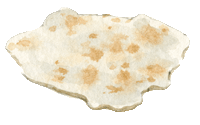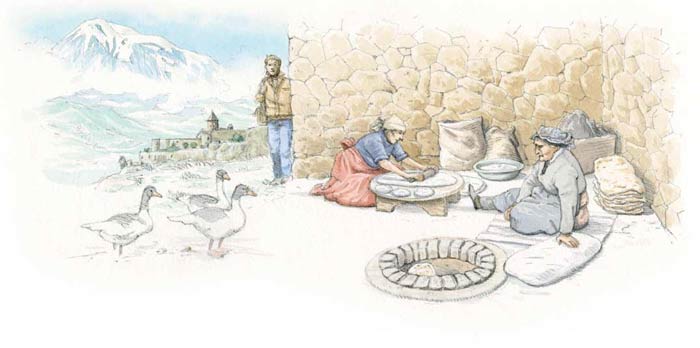lavash

Form: Sheet of bread
Country of origin: Armenia
What distinguishes it from other methods of bread making: Fermentation activated with leaven or sourdough starter, cooked flat against sides of vertical, tanner-type oven
Category of bread: (1) Belongs to category of leaf bread, which also includes Turkish yufka, Yemeni rgâg and Tunisian brick
Particularity: To Armenians, this is the equivalent of the French baguette. It is easy to make, even though it requires a few (secret) tricks of the trade
Ingredients: Wheat flour; leaven or baker’s yeast; plain yogurt; salt; warm water

Armenia
The Armenian people seem to have written its founding myths on this sheet of bread. During a confrontation between the Armenians and the Assyrians, King Aram was taken prisoner. The Assyrian King Nasser, having won, therefore laid down the conditions. After a fast of eleven days, King Aram confronted him in an archery competition. If Aram won, his life was to be saved, and the loser had no choice but to accept, on condition that he be sent his breastplate, with which he wanted to prove his youth, before his match with the Assyrian king.
Assyrian emissaries hurried to bring the breastplate, without knowing that friends of the king hid a thin sheet of bread inside it, which was not discernable because it was so thin. King Aram put on his armor and soon complained that it was not the one he liked most. The king was particular about his appearance. He wanted them to bring him another one, and then another and another. This went on for eleven days, during which the king regularly treated himself to delicious lavishes while held refuge. There are worse imprisonments than that. At the end of his detention, Nassor was amazed to see his competitor, after eleven days of fasting, so well turned out, and winning, to end the competition. When once against amongst his own, Aram consecrated lavash as the bread standard. Armenians were encouraged to give it preference over all other.
There are tons more stories to be told about this thin layer of bread resembling a sheet of paper or cinematographic film. This dough, rolled out using a thin walnut rolling pin into an extra-thin rolled-out dough, not risen even though it is sprinkled with leavening, is thrown onto the walls of a vertical clay oven – a sort of large conical shaped “jar” buried in the dirt and open on both ends. It is eaten like a French crêpe when it is fresh: filled or stuffed; wrapped around a brochette or shish kebab, or eaten with any other food. Once it is dried, it can be kept for months and forms what is called “cracker bread”.

